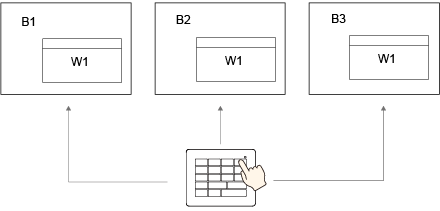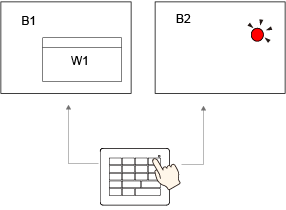![]()
-
For information on models which support the EZ Numpad, see the following.
 1.5 Supported Features
1.5 Supported Features
EZ Numpad (Optional item) can by used as an external numeric keypad and as function keys by connecting it to a display unit via USB.
Since there is no need to display the keypad on the screen when it is used as an external keypad, you can enter numbers and characters while looking at the entire screen.
By using the EZ Numpad as external function keys, it can be used to operate the display unit without touching parts on the screen. Therefore, you can reduce the number of parts placed on the screen and use more of the screen for display purposes.
How to use the EZ Numpad
To use the EZ Numpad, you need to configure GP-Pro EX, and you need to use a display unit that is compatible with the EZ Numpad.
For GP-Pro EX, configure the settings for how to use the EZ numpad and for the function key functions.
![]()
For information on models which support the EZ Numpad, see the following.
![]() 1.5 Supported Features
1.5 Supported Features
This section describes how to configure the settings for using both the numpad and the function keys.
Configure How to Use EZ Numpad in GP-Pro EX
In the [Project] menu, go to [System Settings]-[Input Equipment], and select [Use tenkey and function keys].
Set the Function Key Functions
From the links in the [Global Functions Settings] or [Base Screen] links, configure the function key functions.
Transfer to the display unit
Connect the Display Unit and EZ Numpad
This enables the EZ Numpad to operate usually as function keys and to operate as a numeric keypad only when the applicable part is in the input wait state.
![]()
Switching between the numeric keypad and the function keys can also be done by system variable (#H_NumpadInputMode).
![]() A.2.2.2 Word Type - #H System Variables
A.2.2.2 Word Type - #H System Variables
When using the IPC Series, the EZ Numpad can be operated using two switches at the same time.
Numpad
You can enter numbers and characters. Numpad input is enabled only when the target function such as the data display etc. is in the input wait state.
Target Functions
When Allow Input is selected for the data display
When entering time in the Historical Mode of Historical Trend Graph.
Editing sampled data, Show CSV, and enhanced recipes
Alarm analysis
Entering passwords
![]()
For numbers and characters that can be entered using the EZ Numpad, please see the following:
![]() 16.3 Display Inputs from USB Keyboard/EZ Numpad
16.3 Display Inputs from USB Keyboard/EZ Numpad
Function Key
When using a switch in a common way for an entire project, set a global function for the switch. When using a switch in different ways for different screens, set the local functions for the switch.
Global Function
Pressing the same switch in any screen performs the same operation, which is displaying Window 1

Local Function
You can allocate a different function for different screens to a single function key; for example, opening Window 1 in Screen 1 and for turning ON a lamp in Screen 2.

![]()
One function key can be configured with both local and global functions.